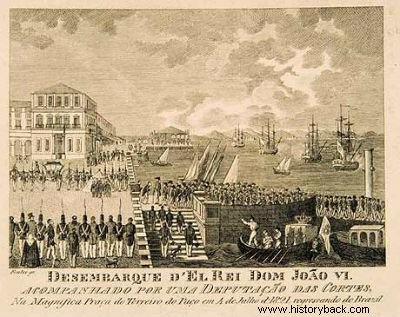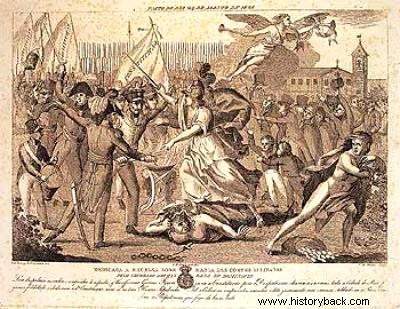The Liberal Revolution of Porto was a movement that took place in 1820, in the city of Porto, in Portugal.
Among several demands, the members demanded the promulgation of a Constitution and the return of the Portuguese Court that was in Brazil.
Historical Context

"Disembarkation of King Dom João VI, accompanied by a deputation of the Cortes, in the magnificent Praça do Terreiro do Paço on July 4, 1821, returning from Brazil".
P>The Portuguese Royal Family, in 1808, had moved to their colony in America due to the Napoleonic invasions.
However, the French Emperor had already been defeated at the Battle of Waterloo and no longer posed any threat to European countries.
During the Congress of Vienna, representatives of European governments refused to comply with the requests of Portuguese ambassadors. They claimed that the Portuguese King would not have the right to voice in the assembly because he ruled the Kingdom from a colony.
In order to calm the mood, Dom João VI, in 1816, elevates Brazil to the category of United Kingdom. Legally, the territory is no longer a colony to be part of the Kingdom, with the same legal status as Portugal.
On the other hand, this meant that Portuguese traders lost their trade monopoly with the colony. In this way, those born in Brazil could trade with the metropolis in the same way.
See also:Congress of Vienna (1814-1815)Porto Revolution
Background
The British had assumed the regency of Portugal while Dom João VI was absent. When Napoleon was defeated many Portuguese thought that the king would return shortly.
However, Dom João VI postponed his return, wishing to remain in the land that had made him king. Some scholars point out that there, the monarch felt free from the pressures of the Court and European powers.
In any case, in 1817, a group of Freemasons and Army officers rebelled in Lisbon, declaring themselves against the British occupation in Portugal and proclaiming themselves regents of the Kingdom. The movement was denounced and its members sentenced to death.
In this way, the political tension was palpable throughout the country.
Oporto Liberal Movement

Allegory of Porto's Liberal Revolution:Liberty crushes tyranny under its feet and soldiers and population carry flags calling for "Constitution".
In the city of Porto, another group dissatisfied with the Court's permanence in Brazil, constitutes the Provisional Board of the Supreme Government of the Kingdom. It was made up of members of the clergy, the nobility and the army and representatives of the cities of northern Portugal.
They wrote a "Manifesto of the Portuguese Nation to the Sovereigns and Peoples of Europe" in which they reaffirmed their allegiance to the King, but demanded the promulgation of a Constitution that limited the sovereign's power. Portuguese commercial.
Other cities join the movement and on September 28 elections are called to form the Constituent Court. In January 1821, the Portuguese Cortes met to prepare the document. Meanwhile, Dom João VI returns to Portugal with part of his family and the nobility who accompanied him.
The eldest son, Dom Pedro, would stay in Brazil as Prince Regent. This, perhaps, was the last great political move of Dom João VI, because leaving his son there, he nourished the hope of keeping the ties between Portugal and Brazil together.
Consequences of the Porto Revolution
- The Portuguese Court returns to Brazil,
- elaboration and promulgation of the first Portuguese Constitution,
- end of the Absolutist State in Portugal,
- articulation of the Brazilian elite around Dom Pedro, who would bring about the Independence of Brazil.
Read more :
- Fique Day
- Independence of Brazil
- Flag of Portugal
- The arrival of the Royal Family to Brazil
- Constitutional Monarchy
- Causes of Brazil's Independence
